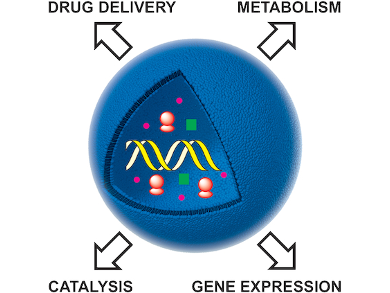Neal K. Devaraj and colleagues, University of California, San Diego, USA, summarized recent advances and the current state-of-the-art of combining functionalized synthetic membranes with biological systems to form hybrid artificial cells. Such studies deepen our understanding of the nature of living systems, of the origin of cellular life, and for advancing synthetic biology.
The library of materials that can reproducibly form membrane assemblies is increasing. Functional channel-forming proteins allow cells to transport cargo. Multicompartmentalized vesicles feature pH-responsive transmembrane channels. Increasing the pH around multivesicle assemblies comprising of acrylic acid (AAc) and distearin acrylate (DSA), for example, allows AAc residues to ionize, opening hydrophilic transmembrane channels.
Multicompartmentalization provides spatio-temporal control over reactions, high local reactant concentrations, concentration gradients, and the separation of incompatible reaction components. These finding have inspired developments in novel microreactor architectures.
Synthetic membranes fabricated by self-assembly have attracted great attention for applications in biocatalysis. An example for a multicompartmentalized catalytic synthetic cell are polystyrene-b-poly(3-(isocyano-lalanyl-aminoethyl)-thiophene) (PS-b-PIAT) nanoreactors. They encapsule enzymes. This is followed by mixing of these artificial organelles with cytosolic enzymes and reagents. The mixture is encapsulated in polybutadiene-b-poly(ethylene oxide) (PB-b-PEO) vesicles to create the functional synthetic cell. Inside this cell enzymatic multicompartment catalysis takes place.
- Towards Self-Assembled Hybrid Artificial Cells: Novel Bottom-Up Approaches to Functional Synthetic Membranes,
R. J. Brea, M. D. Harady, N. K. Devaraj,
Chem. Eur. J. 2015.
DOI: 10.1002/chem.201501229
This is the 20,000th article published by Chemistry – A European Journal. The journal celebrates its 20th anniversary this year.




